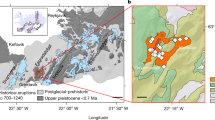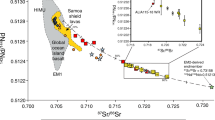Abstract
Lavas erupted within plate interiors above upwelling mantle plumes have chemical signatures that are distinct from mid-ocean ridge lavas. When a plume interacts with a mid-ocean ridge, the compositions of both their lavas changes, but there is no consensus as to how this interaction occurs1,2,3. For the past 15 Myr, the Pacific–Antarctic mid-ocean ridge has been approaching the Foundation hotspot4 and erupted lavas have formed seamounts. Here we analyse the noble gas isotope and trace element signature of lava samples collected from the seamounts. We find that both intraplate and on-axis lavas have noble gas isotope signatures consistent with the contribution from a primitive plume source. In contrast, near-axis lavas show no primitive noble gas isotope signatures, but are enriched in strontium and lead, indicative of subducted former oceanic lower crust melting within the plume source5,6,7. We propose that, in a near-ridge setting, primitive, plume-sourced magmas formed deep in the plume are preferentially channelled to and erupted at the ridge-axis. The remaining residue continues to rise and melt, forming the near-axis seamounts. With the deep melts removed, the geochemical signature of subduction contained within the residue becomes apparent. Lavas with strontium and lead enrichments are found worldwide where plumes meet mid-ocean ridges6,7,8, suggesting that subducted lower crust is an important but previously unrecognised plume component.
This is a preview of subscription content, access via your institution
Access options
Subscribe to this journal
Receive 12 print issues and online access
$259.00 per year
only $21.58 per issue
Buy this article
- Purchase on Springer Link
- Instant access to full article PDF
Prices may be subject to local taxes which are calculated during checkout




Similar content being viewed by others
References
Ito, G., Lin, J. & Graham, D. W. Observational and theoretical studies of the dynamics of mantle plume–mid-ocean ridge interaction. Rev. Geophys. 41, 1017 (2003).
Braun, M. G. & Sohn, R. A. Melt migration in plume–ridge systems. Earth Planet. Sci. Lett. 213, 417–430 (2003).
Hall, P. S. & Kincaid, C. Melting, dehydration, and the geochemistry of off-axis plume–ridge interaction. Geochem. Geophys. Geosyst. 5, Q12E18 (2004).
O’Connor, J. M., Stoffers, P. & Wijbrans, J. R. Migration rate of volcanism along the Foundation Chain, SE Pacific. Earth Planet. Sci. Lett. 164, 41–59 (1998).
Chauvel, C. & Hémond, C. Melting of a complete section of recycled oceanic crust: Trace element and Pb isotopic evidence from Iceland. Geochem. Geophys. Geosyst. 1, 1001 (2000).
Yaxley, G. M. & Sobolev, A. V. High-pressure partial melting of gabbro and its role in the Hawaiian magma source. Contrib. Mineral. Petrol. 154, 371–383 (2007).
Sobolev, A. V., Hofmann, A. W. & Nikogosian, I. K. Recycled oceanic crust observed in ‘ghost plagioclase’ within the source of Mauna Loa lavas. Nature 404, 986–990 (2000).
Haase, K. M., Devey, C. W. & Goldstein, S. L. Two-way exchange between the Easter mantle plume and the Easter microplate spreading axis. Nature 382, 344–346 (1996).
Ito, G. & Lin, J. Oceanic spreading centre–hotspot interaction: Constraints from along-isochron bathymetric and gravity anomalies. Geology 23, 657–661 (1995).
Schilling, J-G., Thompson, G., Kingsley, R. & Humphris, S. Hotspot-migrating ridge interaction in the South Atlantic. Nature 313, 187–191 (1985).
Coffin, M. F. & Gahagan, L. M. Ontong Java and Kerguelen Plateaux: Cretaceous Icelands? J. Geol. Soc. Lond. 152, 1047–1052 (1995).
Haase, K. M. The relationship between the age of the lithosphere and the composition of oceanic magmas: Constraints on partial melting, mantle sources and the thermal structure of the plates. Earth Planet. Sci. Lett. 144, 75–92 (1996).
Keller, R. A., Fisk, M. R. & White, W. M. Isotopic evidence for Late Cretaceous plume–ridge interaction at the Hawaiian hotspot. Nature 405, 673–676 (2000).
Maia, M. et al. The Pacific–Antarctic Ridge-Foundation hotspot interaction: A case study of a ridge approaching a hotspot. Mar. Geol. 167, 61–84 (2000).
Maia, M., Hémond, C. & Gente, P. Contrasted interactions between plume, upper mantle, and lithosphere: Foundation chain case. Geochem. Geophys. Geosyst. 2, 1028 (2001).
Stroncik, N. A., Niedermann, S. & Haase, K. M. Plume–ridge interaction revisited: Evidence for mixing of melts from He, Ne and Ar isotope and abundance systematics. Earth Planet. Sci. Lett. 268, 424–432 (2008).
Haase, K. M., Stroncik, N. A., Hekinian, R. & Stoffers, P. Nb-depleted andesites from the Pacific–Antarctic Rise as analogs for early continental crust. Geology 33, 921–924 (2005).
Ozima, M. & Podosek, F. A. Noble Gas Geochemistry 2nd edn (Cambridge Univ. Press, 2002).
Ito, G. & van Keken, P. E. Hot spots and melting anomalies. Treatise Geophys. 7, 371–435 (2007).
Bianco, T. A. et al. Geochemical variation at the Hawaiian hot spot caused by upper mantle dynamics and melting of a heterogeneous plume. Geochem. Geophys. Geosyst. 9, Q11003 (2008).
Phipps Morgan, J. & Morgan, W. J. Two-stage melting and the geochemical evolution of the mantle; A recipe for mantle plum-pudding. Earth Planet. Sci. Lett. 170, 215–239 (1999).
Devey, C. W. et al. Giving birth to hotspot volcanoes: Distribution and composition of young seamounts from the seafloor near Tahiti and Pitcairn Island. Geology 31, 395–398 (2003).
Harpp, K. S. & White, W. M. Tracing a mantle plume: Isotopic and trace element variations of Galapagos seamounts. Geochem. Geophys. Geosyst. 2, 1042 (2001).
Haase, K. M. & Devey, C. W. Geochemistry of lavas from the Ahu and Tupa volcanic fields, Easter Hotspot, southeast Pacific: Implications for intraplate magma genesis near a spreading axis. Earth Planet. Sci. Lett. 137, 129–143 (1996).
Huang, S. & Frey, F. A. Recycled oceanic crust in the Hawaiian plume: Evidence from temporal geochemical variations within the Koolau shield. Contrib. Mineral. Petrol. 149, 556–575 (2005).
Saal, A. E. et al. The role of lithospheric gabbros on the composition of Galapagos lavas. Earth Planet. Sci. Lett. 257, 391–406 (2007).
Dasgupta, R. et al. Trace element partitioning between garnet lherzolite and carbonatite at 6.6 and 8.6 GPa with applications to the geochemistry of the mantle and of mantle-derived melts. Chem. Geol. 262, 57–77 (2009).
Stein, C. A. & Stein, S. A. A model for the global variation in oceanic depth and heat-flow with lithospheric age. Nature 359, 123–129 (1992).
Hofmann, A. W. Chemical differentiation of the Earth: The relationship between mantle, continental crust, and oceanic crust. Earth Planet. Sci. Lett. 90, 297–314 (1988).
Graham, D. W. in Noble Gases in Geochemistry and Cosmochemistry Vol. 47 (eds Porcelli, D., Ballentine, C. J. & Wieler, R.) 247–317 (Mineralogical Soc. Am., 2002).
Acknowledgements
We thank D. Ackermand, B. Mader and D. Garbe-Schönberg (Institut für Geowissenschaften, University of Kiel) for help with the major and trace element analyses; S. Niedermann (GFZ Potsdam) provided extensive support for the noble gas analyses. B. Holtzman, B. White, D. Geist provided constructive comments on earlier versions of the manuscript which helped to improve this paper greatly. Sampling was carried out from research vessel S o n n e financed by the German Ministry of Science and Technology (BMBF).
Author information
Authors and Affiliations
Contributions
N.A.S. was responsible for noble gas analyses, C.W.D. supervised trace element analyses. Both authors worked equally on writing and revising the paper and developing the ideas it contains.
Corresponding author
Ethics declarations
Competing interests
The authors declare no competing financial interests.
Supplementary information
Supplementary Information
Supplementary Information (PDF 407 kb)
Rights and permissions
About this article
Cite this article
Stroncik, N., Devey, C. Recycled gabbro signature in hotspot magmas unveiled by plume–ridge interactions. Nature Geosci 4, 393–397 (2011). https://doi.org/10.1038/ngeo1121
Received:
Accepted:
Published:
Issue Date:
DOI: https://doi.org/10.1038/ngeo1121
This article is cited by
-
Peridotites, chromitites and diamonds in ophiolites
Nature Reviews Earth & Environment (2021)
-
Seawater cycled throughout Earth’s mantle in partially serpentinized lithosphere
Nature Geoscience (2017)



